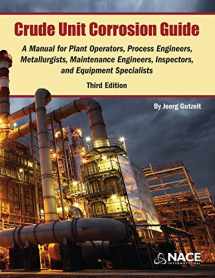
Crude Unit Corrosion Guide: A Manual for Plant Operators, Process Engineers, Metallurgists, Maintenance Engineers, Inspectors, and Equipment Specialists
Book details
Summary
Description
The Crude Unit Corrosion Guide was written for plant operators, process engineers, metallurgists, maintenance engineers, inspectors, and all others who deal daily with corrosion and fouling issues. In the past, most refineries also employed corrosion engineers. That position has all but disappeared as the experienced practitioners moved on, retired, or were replaced by engineering contractors, equipment builders, and process additives suppliers.
Like the earlier editions of the Guide, this revised 3rd Edition is based primarily on the experience of the author, Joerg Gutzeit, M.S.ChemEng, in dealing with all aspects of corrosion and fouling in crude units. The Guide also reflects the Industry’s consensus experiences reported at past meetings of the NACE STG34 Committee on Petroleum Refining and Gas Processing (formerly T8 Committee on Refining Industry Corrosion) and the API Subcommittee on Corrosion and Materials. Diluent recovery units (DRUs) and vacuum distillation units (VDUs) of bitumen upgraders are quite similar to crude units with similar corrosion and fouling issues and are now included in the discussions where appropriate. In addition to corrosion and fouling issues with the usual 3 or 4 crude types, the Guide now covers various bitumen-derived crudes, including synthetic crude, dilbit crude, synbit crude, and shale crude all of which have come to market in recent years.
In many ways, refinery corrosion and fouling control remained more “art than science.” Despite college-level courses in corrosion and materials science and ongoing efforts by NACE, API, and ASM, few resources for practical training on plant corrosion and fouling control are available. In recent years, process simulation (PS) and risk-based inspection management (RBIM) software has been very helpful for identifying and ranking critical components on which to concentrate future inspection and maintenance efforts. However, a certain amount of expertise is still required to facilitate reliable data input and assessment. The Guide attempts to present in compact form what the author considers the most important aspects of corrosion and fouling control in the atmospheric and vacuum sections of crude units and the corresponding sections in bitumen upgraders. Various chapters deal with general corrosion characteristics of different feedstocks; materials of construction (metallurgy); corrosion and fouling monitoring; feedstock preparation by tank settling, desalting, and caustic injection; and the types of damage seen in major components. Other chapters cover specific topics, including preheat exchanger fouling; high-temperature corrosion and fouling by organic sulfur compounds and naphthenic acids in fired heaters, transfer lines, and distillation columns; low-temperature corrosion and fouling by inorganic chlorides in the top of columns and in overhead systems; organic chloride problems; and various issues with neutralizer, corrosion inhibitor, and water injection systems.


We would LOVE it if you could help us and other readers by reviewing the book
Book review


